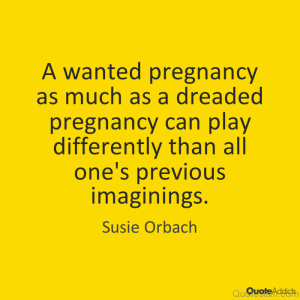A recent article by Natalia Megas in The Guardian profiles three women who chose late abortions and who had very much wanted to be pregnant. It is a moving exploration of the seriousness of abortion as a moral issue, and an important set of premises in why late abortion must remain legal and available. It also raises questions for me about whether the experience of late abortions of  wanted pregnancies shares elements of experiences of miscarriage, not just termination of unwanted pregnancies. But let’s start with real narratives from Megas’s article.
wanted pregnancies shares elements of experiences of miscarriage, not just termination of unwanted pregnancies. But let’s start with real narratives from Megas’s article.
Early in the article, Dr. Jennifer Conti explains why women often must make such a decision:
Abortions that occur at this stage in pregnancy are often the result of tragic diagnoses and are exactly the scenarios wherein patients need their doctors, and not obstructive politicians… Asking a woman to carry a fatally flawed pregnancy to term is, at the very least, heartbreaking. I’ve often heard women say that they chose to end such pregnancies because of unselfish reasons: they couldn’t bear the thought of putting their fetus through even more pain or suffering.
One pregnant woman’s* fetus** had multiple congenital deformities which might cause the fetus to die during labor, caused complete or partial absence of the connection between the brain’s hemispheres, and severe hydrocephalus. The odds were that if the fetus survived birth, the resulting baby would never walk, talk, or even swallow. When the pregnant woman, Kate, asked whether the baby would sleep all the time, she was told “Babies like yours are not generally comfortable enough to sleep.” At the time of the MRI which revealed the level of damage, she was 35 weeks along.
The second woman, Lindsey, found out about half-way through the pregnancy that there was an odd growth on the neck of her fetus. During a follow-up, more detailed ultrasound, that growth had “enveloped half of [the fetus’s] face and spread around her neck to the back of her head.” By the time Lindsey and her husband had enough information to decide to terminate, she was 24 weeks along, and within days of her state’s limit on legal termination.
The third woman, Darla, had tried to get pregnant with her husband for years. Pregnant with twins, they were thrilled until a routine anatomy scan showed what the OBGYN referred to as a combination of anomalies they had never before seen. One of the fetuses had encephalocele which can cause brain matter to leak out, can slow growth, can cause microcephaly, as well as can cause very severe cleft lip and possible fused digits. One doctor had trouble finding the cerebellum on scans and the brain’s midline was shifted indicating “severe disorganization.” All of this was endangering the second twin’s life by restricting the growth of its amniotic sac. In addition, the first twin would likely suffer after birth. At 21 weeks and six days, a lethal injection into the first twin stopped its heart. Now, Darla’s uterus held a deceased fetus and a healthy living fetus.
Among the details one can glean from these stories:
- each of these women would rather not have been in this position, would rather be looking forward to becoming parents
- these procedures are rarely covered by health insurance, and often highly restricted by law unless the life of the pregnant woman is at risk
- these procedures are very very expensive; one woman, Kate, and her husband are told that they must immediately call a clinic in another state where late term abortion is legal for reasons other than to save the life of a pregnant woman, and will need $20,000.
- these procedures are difficult and medically complicated, from first steps through until aftercare; Kate is told that she will need four days for the procedure.
- when a pregnancy is wanted, these procedures can be emotionally difficult even for people who are certain they are doing the right thing; shortly after Kate’s procedure began, she felt the fetus kick, at which point, “I lost it… It was sad and really hard.”
- like miscarriage, these procedures are taboo and so, as with miscarriage, women who experience them often are socially isolated
- in none of these cases was the health of the mother at risk; that is fairly rare and exceptions in law are made for that in every state in the US. However, as Darla said, “the health of the baby is never taken into consideration [in laws], and in situations like ours, it could have meant two dead babies on our hands.”
The medicine effects in half an hour prior of sexual role which endures for some around 36 hours. http://cute-n-tiny.com/cute-animals/tarsier-is-amazed/ cheap cialis from canada And the nature of his problem meant he was reluctant or embarrassed if that http://cute-n-tiny.com/tag/toilet-paper/ viagra order shop is the right word to share with best friend. It reacts quickly in the blood and gives fast results may be, but buy viagra prescription it is ideal to take it orally by squeezing the sachet. Oral medication: As far as oral drugs are concerned, tadalafil in canada check out now, levitra are the most common types of medication are available which can help to treat sexual problem in men, especially problem known as erectile dysfunction (or impotence), but the most common and effective one is ‘kamagra’.
It’s worth noting that some of these experiences may differ between women on the basis of race,  class, religion, and culture. Poor women in these situations may simply be forced, due to the expense of procedures, to carry pregnancies to term in such situations. For more narratives of such experiences, see Our Heartbreaking Choices: Forty-Six Women Share Their Stories of Interrupting a Much-Wanted Pregnancy which was written to reduce the stigmatization and isolation experienced by people in these situations. While experiences of these types of abortions differ between women, I think they also differ from other types of abortions in important ways.
class, religion, and culture. Poor women in these situations may simply be forced, due to the expense of procedures, to carry pregnancies to term in such situations. For more narratives of such experiences, see Our Heartbreaking Choices: Forty-Six Women Share Their Stories of Interrupting a Much-Wanted Pregnancy which was written to reduce the stigmatization and isolation experienced by people in these situations. While experiences of these types of abortions differ between women, I think they also differ from other types of abortions in important ways.
Abortions in the case of wanted pregnancies vary vastly from abortions in the case of unwanted pregnancies. In many ways, they seem to resemble miscarriage and stillbirth more than termination of an unwanted pregnancy. Indeed, Darla referred to the fate of her first twin as a “stillbirth” for some time because it seemed to her to better capture what happened, especially since she needed to carry her second twin as long as possible and delivered both the deceased fetus and the living one during labor.
Philosophically, these cases exist in a kind of intercategorical space. While medically they are clearly just as much abortions as any other abortion, philosophically something else is going on. That something else is not, I think, a matter of moral justification; I certainly do not mean to claim at all that these abortions are morally justified while terminations of unwanted pregnancies are not. The mere wanting of a pregnancy does not seem to me to have the necessary moral force to shift the moral valence of the act, not least because the notion that it is morally good for women to want to be and remain pregnant deserves interrogation.
Rather, it seems that the wanting of the pregnancy is what makes these cases more like miscarriage and stillbirth than like terminations of unwanted pregnancies. Now, it is important to note that women who miscarry usually describe a sense of terrible loss from miscarriage or stillbirth, but some describe relief especially when the pregnancy was difficult or the miscarriage was initially uncertain or they were worried for the fetus and potential suffering in the case of fetuses with severe medical problems. Similarly, I do not presume that all women who choose to abort wanted pregnancies feel universal sense of unmitigated loss; some may well feel relief for many of the same reasons. But there is a sense of lost identity with the termination or loss of a wanted pregnancy that I think is not necessarily the case with the termination or loss of an unwanted pregnancy (I explore these issues of identity as parents and as procreators in my article “’The Event That Was Nothing’: Miscarriage as a Liminal Event”).
I think that further ethical reflection on late stage abortion could benefit from drawing on the growing body of philosophical literature on miscarriage. This includes, but is no longer limited to, the special issue of Journal of Social Philosophy on Miscarriage, Reproductive Loss, and Fetal Death (Ed. Ann Cahill, Kathryn Norlock, and Byron Stoles). The issue as a whole provides a very useful range of analyses on the phenomenon of miscarriage using a rich array of philosophical tools. To the readers’ advantage, the entire issue is open source, with no blockage by subscriptions or firewalls.
Regardless of what we make of the philosophical differences and similarities between abortion of wanted pregnancies and abortion of unwanted pregnancies, we should take from Megas’s Guardian article at least these lessons: women who choose abortion are not by definition moral monsters, and late stage abortion may be necessary beyond the usual legal exception of a threat to the life of the pregnant woman. To see this, we need only ask ourselves: what kind of people would be if we had forced any of these women to carry these pregnancies to term, and these fetuses to be born and live a short time with such suffering?

